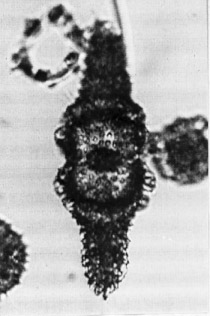 Didymocyrtis
laticonus (Riedel)
Didymocyrtis
laticonus (Riedel) Didymocyrtis
laticonus (Riedel)
Didymocyrtis
laticonus (Riedel)Cannartus laticonus Riedel, 1959, p.291, pl.1, fig.5
Didymocyrtis laticonus (Riedel), Sanfilippo and Riedel, 1980, p.1010
Cortical twin-shell rather thick-walled, with pores subcircular or circular, ten to thirteen on the half-equator. On the broader parts of the shell, on either side of the equatorial constriction, are pronounced obtuse moundlike protuberances, at which the shell wall is thickened; there is a tendency in some specimens for these protuberances to be so arranged that two girdles of them encircle each half of the twin-shell. At each pole of the shell arises a broadly subconical, densely spongy column, which is almost as broad at its base as the polar surface of the twin-shell. Medullary shells two (or perhaps only one in some specimens), of which the inner is spherical and the outer spherical or lenticularly compressed. This species is distinguished from all others of the genus by the broadly subconical polar columns (Riedel, 1959).
Based on 20 specimens. Length of polar columns 45-70 µm; median breadth 28-40 µm. Length of cortical shell 93-125 µm; maximum breadth 68-113 µm. Breadth of outer medullary shell 30-35 µm (Riedel, 1959).
The equatorially constricted cortical shell has a tuberculate surface, and bears wide, spongy polar columns. There are no pronounced caps, but a parallel-sided clear zone, no wider than the height of the tubercules, separates the cortical shell from the columns (Cannartus laticonus in Riedel and Sanfilippo, 1978a).
Westberg and Riedel (1978) used this name only for specimens "in which the height of the clear zone below the spongy column is less than 0.2 the length of the cortical shell."
D. laticonus is distinguished from its ancestor, D. mammifera, by having "clear zones" parallel to the cortical shell. In addition, the spongy columns tend to be wider than those of D. mammifera. It differs from its descendant D. antepenultima in that the proportion of the length of the clear zone (cap) to the length of the cortical shell is less than 0.20 (Sanfilippo et al., 1985).
D. laticonus has a tuberculate, equatorially constricted cortical shell with a clear zone at the base of each broad spongy column, parallel to the end of the cortical shell. Tubercles vary from 0.2 the length of the cortical shell to very minor protuberances. In the early part of the range, where D. laticonus has just evolved from D. mammifera, some specimens have spongy columns somewhat narrower and less robust than the very wide co]umns (at least 0.6 times the greatest width of the cortical shell) characteristic of the species (Sanfilippo et al., 1985).
D. laticonus is found in all assemblages of late middle Miocene age from latitudes lower than 40°. It evolved from Didymocyrtis mammifera within the Dorcadospyris alata Zone and evolved into Didymocyrtis antepenultima within the Didymocyrtis antepenultima Zone.
D. laticonus evolved from D. mammifera and developed into D. antepenultima.
Additional illustrations can be found in Westberg and Riedel, 1978, pl.2, figs.1-3.